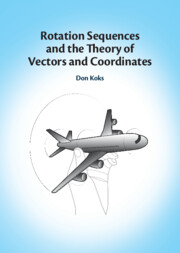Book contents
- Frontmatter
- Contents
- Preface
- 1 Setting the Scene
- 2 Trigonometry, the Foundation of Coordinate Theory
- 3 The Vector Dot and Cross Products
- 4 Vector Preliminaries and Constructing a Basis
- 5 Converting Vector Coordinates Across Bases
- 6 Vector Rotation in Two and Three Dimensions
- 7 Rotation Sequences and the Fundamental Theorem
- 8 Coordinate Systems for Earth, and More Rotation Sequences
- 9 The Role of Quaternions in Rotation Theory
- 10 Time Dependence of Vehicle Attitude
- 11 Frame Dependence of the Time Derivative
- 12 Earth’s Orientation in Space, and Time on Earth
- 13 Orbital Mechanics
- 14 Rigid-Body Dynamics
- 15 Modelling the Motion and Attitude of a Vehicle
- 16 Concepts of Tensor Analysis
- Index
8 - Coordinate Systems for Earth, and More Rotation Sequences
Published online by Cambridge University Press: 17 April 2025
- Frontmatter
- Contents
- Preface
- 1 Setting the Scene
- 2 Trigonometry, the Foundation of Coordinate Theory
- 3 The Vector Dot and Cross Products
- 4 Vector Preliminaries and Constructing a Basis
- 5 Converting Vector Coordinates Across Bases
- 6 Vector Rotation in Two and Three Dimensions
- 7 Rotation Sequences and the Fundamental Theorem
- 8 Coordinate Systems for Earth, and More Rotation Sequences
- 9 The Role of Quaternions in Rotation Theory
- 10 Time Dependence of Vehicle Attitude
- 11 Frame Dependence of the Time Derivative
- 12 Earth’s Orientation in Space, and Time on Earth
- 13 Orbital Mechanics
- 14 Rigid-Body Dynamics
- 15 Modelling the Motion and Attitude of a Vehicle
- 16 Concepts of Tensor Analysis
- Index
Summary
An important set of coordinates to understand is that of our oblate Earth. I derive the equations transforming latitude/longitude/height to and from the ECEF cartesian axes. I use the model aircraft of a previous chapter as an aid to visualise the rotation sequences that are useful for calculating NED or ENU coordinates at a given point on or near Earth’s surface. I use these in a detailed example of sighting a distant aircraft. This leads to a description of the ‘DIS standard’ designed for such scenarios. I also use these ideas in a detailed example of estimating Earth’s gravity at a given point, which is necessary for implementing inertial navigation systems.
Keywords
- Type
- Chapter
- Information
- Rotation Sequences and the Theory of Vectors and Coordinates , pp. 221 - 259Publisher: Cambridge University PressPrint publication year: 2025

